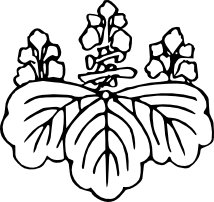Recreational research into Feudal Japan
Posts tagged paulownia
Mon of the Samurai
May 3rd (a Butsumetsu (仏滅))
Widespread battlefield use of mon seems to date to the Gempei War (1180-1185), where they were used on banners alongside Buddhist prayers, Shintō invocations, and heroic poetry. While it’s unclear if the two warring clans actually used the mon they were later associated with (butterfly for the Taira, gentian for the Minamoto), Heike Monogatari does contain clear references to mon on banners.(SH:10)
By the Muromachi period (1336–1573), samurai commonly adopted mon to identify themselves. A compilation of mon used by provincial samurai from around 1460–1470 shows some interesting things. While most of the elements are recognizable from modern mon, there are some elements and variation that did not persist. Without a central authority, samurai were less constrained in terms of shape, arrangement, and combination of elements than post-standardization mon from the Edo period.(KJ:7)
Here is a sample from this compilation: a classic paulownia mon with the insertion of the character 安 or ‘peace’. These are both common elements, though the location of a character in the middle of the flower is an unusual arrangement that did not end up becoming standard.(KJ:7)
Mon: Japanese Crests
Mar 22nd (a Tomobiki (友引))
Mon, or Japanese crests, are one of my favorite Japanese design elements. Mon served much the same purpose as European heraldry: they were used for identification on the battlefield, to mark personal property, and to show family relationships, and sometimes they were given by a superior as a mark of honor. Mon are much simpler, design-wise, then European devices, however. For one thing, mon are monochromatic: color is not considered part of a mon, and the same mon could be drawn white on black, blue on yellow, or any number of other combinations. Secondly, while European devices can be divided in all sorts of different ways and incorporate a large variety of charges, mon tend to be of a few simple designs: one to eight or so copies of a single element, possibly in an enclosure of some sort. There are some patterns that incorporate two elements, but mon never reached anywhere near the density of European devices. Mon favor plant motifs, with the animal motifs favored in Europe quite rare, with the main exception being occasional birds.(JM:Heraldry)
Design elements that would later be mon date back to the Nara period (710–784). These designs were initially used on carriages and clothing, and first saw widespread use in battle in the Kamakura period (1185–1333).(SH:7,12) They were used by the court nobility and by samurai up until the Edo period (1603–1868), when their use, under strict regulations, spread to actors and merchants. Mon are still used today, their clean designs lending themselves to corporate logos such as that of Mitsubishi, which is actually named for the mon used as its logo (“three diamonds”).
There are many interesting categories of mon I could discuss, but let me start with the big, obvious one: Imperial mon. The 16-petaled chrysanthemum has long been the symbol of the Imperial family. Some historians think it actually originated as a stylized sun, referring to the Imperial line’s heritage as descendants of the sun goddess. This was one of the few mon that had usage restrictions on it even before the Edo period; the mon proper was restricted to the Emperor’s household, with the variant of a 14-petaled chrysanthemum seen from the rear for imperial princes, and other variations used by other members of the imperial family at various times. Those who one the favor of the Emperor would sometimes be given permission to use a mon incorporating the chrysanthemum, such a crest being a symbol of imperial favor but also loyalty to the Emperor. Similarly, during their rule of Japan the Ashikaga shōgunate was given use of the paulownia (kiri) mon by the Emperor, and in turn would grant the right to use mon based on it to loyal followers.(SH:6)
Still, most mon were much less strictly defined, and I’ll discuss more about mon and variation another time.





